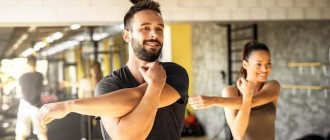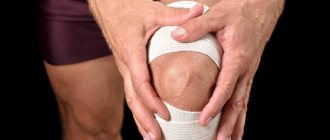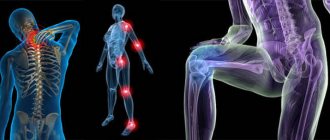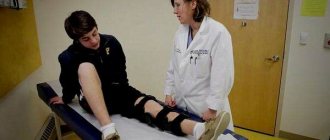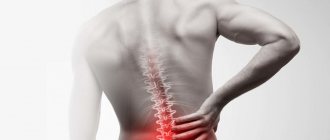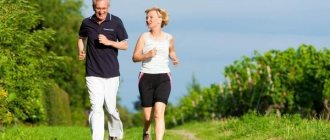Article on the topic
Don't give up ahead of time! Arthrosis can and should be fought
No matter how different in shape (tubular, spongy or flat), in size or position in the body the bones may be, all of them (and there are about 200 of them) are essentially a type of connective tissue and form the main frame of a person - the skeleton. It is the bones that are entrusted with protecting many internal organs and serving as their support. Together with muscles, joints, and tendons, they form a system of levers, thanks to which a person can move and withstand heavy loads. In addition, bones also perform biological functions, participating in metabolism and hematopoiesis. Our skeleton is by no means bone: throughout our lives, two inextricably linked processes take place in it - resorption and the formation of new tissue. But if before the age of 20, during rapid growth and accumulation of bone mass, the creative principle predominates, then from the age of 35, after a period of some stabilization, natural age-related bone atrophy occurs - the skeleton gradually begins to “dry out.”
Bones love
“Calcium is my love!” - the bones would exclaim if they could speak. Without it, their life becomes fragile and brittle, but in union with it, the bones retain wonderful strength and elasticity until old age.
Drink milk every day, eat yogurt, cottage cheese, cheeses (hard varieties contain almost 2 times more calcium than processed ones).
For greens, give preference to celery and lettuce. Bones are delighted with dried apricots, almonds and even more so with sesame seeds. And fish, especially dried fish, is generally the height of bliss: 100 g of this product contains about 3 g of calcium!
They cannot exist without phosphorus and magnesium, which take an active part in the formation of bone tissue. And they will be very grateful if you begin to include legumes, offal, nuts, seeds, cucumbers, cabbage, raisins, and prunes in your diet.
They have tender feelings for manganese, which helps transport oxygen from the blood to bone cells. That’s why they love it when you have dishes from liver, kidneys, poultry, bananas, and various vegetables on your table.
Bones love the sun dearly - but in moderation! Penetrating through the skin, ultraviolet rays force the body to produce vitamin D, which regulates calcium-phosphorus metabolism. To get the optimal dose, there is no point in sunbathing on the beach - just walking for 2-3 hours in a shady park on a sunny day is enough.
The direct and beneficial effect of physical exercise on the formation of our skeleton has long been proven. Muscle activity is important not only for children and adolescents gaining bone mass, but also for mature, elderly people. Gymnastics and swimming are very useful. Regular walking for 1-1.5 hours is required (and not stomping around in the kitchen, when there is no obvious activation of blood circulation, and all our organs, including bones, are not working in optimal mode). Are you lazy? Then get a dog. Obliges!
How to help your joints become healthier?
1. Healthy weight. Maintaining weight at a normal level allows the joints to receive optimal and correctly distributed load. 2. Balanced diet. A varied diet rich in vitamins and microelements has a positive effect on the condition of joints. They will benefit greatly from low-fat dairy products rich in calcium. 3. Correct posture. Comfortable furniture and the correct location of the monitor and computer keyboard allow you to maintain normal posture. A five-minute warm-up at the end of every hour will relieve tension in your arms and help keep your joints healthy. 4. Comfortable shoes. Non-constrictive shoes with stable low heels will allow the foot and leg joints to maintain the balance of the body without unnecessary stress and protect them from injury. 5. Reasonable physical activity. Regular physical activity without overexertion will help not only avoid accidental injuries, but also strengthen your joints. Not only sports are suitable, but also, for example, walking, dancing, cycling or outdoor games.
They don't like bones
A sedentary lifestyle is not to the liking of the skeleton: slow blood circulation and metabolic processes impair the nutrition of bone tissue.
For example, in cosmonauts, due to a long stay in weightlessness and the lack of vertical static load (even exercise bikes can’t help!), the microarchitecture of bone tissue is disrupted and osteoporosis develops. Upon returning to Earth, they have to undergo a long rehabilitation.
How important static load is for the skeleton is shown by this experience. Two rats were hung by their front legs. During the entire experiment, one could not reach the floor of the cage with her hind legs, while the other calmly rested on it. Soon the first, deprived of support, bones became thinner and osteoporosis began to develop.
However, bones can withstand excessive loads with creaking, especially with an incorrectly chosen vector of application of force. They inhibit growth, cause deformation and often lead to fractures. Don't lift heavy weights! And if absolutely necessary, distribute the load evenly and keep it close to the body. Do not jerk anything heavy off the floor!
An uneven surface that moves away from under our feet is dangerous for our support. So that you don’t end up in a cast because of ice, a small hole or a watermelon rind that accidentally “turned up” on the way, be careful what road you’re walking on. Are you elderly? Take care of your bones: do not climb ladders or stepladders, do not run after a departing bus or trolleybus.
A sharp change in climate zone is also undesirable. In southerners who find themselves in harsh Nordic conditions, due to lack of sun, bone tissue often begins to soften: the process of mineralization and calcium deposition is disrupted. If you have a long business trip to the North, stock up on vitamin D (the dose will be prescribed by your doctor), and eat more dairy products.
The frame is weakened by long-term use of hormonal drugs and tetracycline antibiotics.
The worst enemy of bones is alcohol, since ethanol directly inhibits the process of bone formation. They soften, become increasingly brittle and brittle.
Sugar is poison for our skeleton: it pulls calcium, phosphorus, magnesium and manganese from the bones. And they react to the deficiency of these vital microelements with all sorts of fractures. Replace sugar with honey, raisins, and other dried fruits.
Can't part with a cigarette? But among smokers, osteoporosis occurs several times more often than among tobacco opponents.
Bones also suffer from environmental pollution. For those living in environmentally unfavorable places (in large cities with smog, near chemical plants, pulp and paper mills), doctors note an increase in bone tissue diseases, which often leads to the development of osteoporosis at a young age. People living in such conditions need to spend more time in nature and take care of preventing damage to their support from a young age.
Main causes of diseases
There are 4 main causes of joint pathologies:
- birth defects that disrupt the biomechanics of the “hinge”;
- injuries;
- inflammatory processes caused by autoimmune diseases (rheumatoid arthritis, etc.), as well as infections (borreliosis, syphilis, etc.);
- age-related degenerative changes in cartilage.
To keep joints healthy, it is necessary, if possible, to avoid the above reasons. But even if it is not possible to avoid the disease, then treatment using the unique method of Dr. S.M. Bubnovsky will help restore health.
Calcium does not harm the kidneys
Some believe that calcium is harmful: it supposedly leads to arthrosis and the formation of kidney stones. Against! Such diseases often arise precisely because of calcium deficiency - hypocalcemia. After all, calcium takes part in all vital processes of the body - the formation of cells, enzymes, and the functioning of receptors. And if it becomes insufficient with age (both due to decreased consumption and worsening absorption in the intestine), compensatory mechanisms are activated that take calcium from the bones. In order not to disrupt the metabolic processes in the body and not lead to softening of bone tissue and osteoporosis, doctors recommend taking additionally about 0.8-1.0 g (for women after menopause up to 1.5 g) of calcium salts daily for prevention. These can be tablets of calcium carbonate or tribasic calcium phosphate. And if you have a strange desire to taste chalk, tooth powder is the first symptom that there are not enough calcium salts in the body.
Mikhail Avduevsky
Competition “Bio/Mol/Text”-2020/2021
This work was published in the “Own Work” category of the “Bio/Mol/Text” competition - 2020/2021.
The general partner of the competition is the annual biotechnology conference BiotechClub, organized by the international innovative biotechnology company BIOCAD.
The nomination partner is the Russian Science Foundation.
The sponsor of the competition is SkyGen: a leading distributor of life science products on the Russian market.
Competition sponsor: the largest supplier of equipment, reagents and consumables for biological research and production.
"Book" sponsor of the competition - "Alpina Non-Fiction"
In recent years, much attention has been paid to joint diseases in science: this is not surprising, because this problem is becoming increasingly urgent - over the past century, osteoarthritis alone has increased 8 times more [1]! Unfortunately, this figure is growing every year, and patients are getting younger. However, by studying people with already developed joint disease, we lose sight of those who are still healthy! Well, or almost healthy. I wonder if everything is normal with the joints of people in their twenties? What if this is where the reasons lie that decades later force a person to see a doctor?
By measuring and studying joint mobility in 100 people aged 18–23 years, we discovered interesting patterns. Firstly, women's joints turned out to be more mobile than men's. Differences in mobility were noted across the four parameters, ranging from 5 to 17 degrees. The first parameter is the magnitude of the ulnar angle. Perhaps many do not know what this indicator is: it includes extension at the shoulder joint with simultaneous flexion at the elbow joint and placing the hand and forearm behind the back; the hand is located as high as possible between the shoulder blades; in this case, the angle between the shoulder and forearm is measured. The remaining parameters are hip abduction, active and passive plantar flexion of the foot. There are two possible reasons for changes in mobility: one lies in the field of physics, and the other in endocrinology.
The first reason is that soft tissues (muscles, tendons, skin) have special biomechanical properties, one of which is stiffness. Stiffness is the ability of tissues and organs to resist changes in shape when exposed to external forces. Stronger muscles have higher stiffness. Muscle strength, in turn, depends on the following components: signals coming from motor neurons, the type of muscle fibers, and the mode of muscle energy exchange. If we consider a muscle in isolation, the strength of muscle contraction directly depends on the number of muscle fibers [2]. With regular physical activity - for example, during training - the ratio of the number of different types of muscle fibers changes, and there is also a general increase in their number and size [3].
However, let's get back to the tough stuff. Tissues with increased rigidity limit the action of antagonist muscles during movement. In this case, to stretch these muscles and overcome their stiffness, it is necessary to perform more work and increase energy expenditure during movement [4].
Agonists are skeletal muscles with the help of which a certain movement is carried out. Antagonists are muscles that oppose agonists. In different situations, the same muscles can act as both agonists and antagonists; binding to a specific movement is necessary (Fig. 1). For example, in the case of forearm flexion, the agonist would be the biceps brachii muscle and the antagonist would be the triceps brachii muscle. If the stiffness of the triceps is increased, the biceps will have to exert more effort to complete the movement.
Figure 1. Agonist and antagonist muscles in the case of forearm flexion and extension.
TardokAnatomy website
Foreign researchers have found that tendon stiffness in men is higher than in women [5]. Thus, women, having lower muscle and tendon stiffness, are able to perform movements with greater amplitude.
In addition, specific estrogen receptors were found in the articular cartilage of women; When the levels of these hormones decrease after menopause, cartilage fragility increases [6].
There are two types of intracellular estrogen receptors, representing two separate genes with different chromosomal locations, called ER-α and ER-β. Both types of receptors have been found in articular chondrocytes [7].
This discovery allows us to look for the reason for the greater mobility of female joints precisely in the area of cyclical changes in female sex hormones throughout life. And if we consider that just after menopause, the incidence of osteoarthritis in women rapidly increases and at the age of 50 it overtakes men, then the relationship between sex hormones and joint health in women becomes quite obvious [8–10]. However, the subtle molecular mechanisms by which estrogens influence joint health have yet to be fully established [7].
Despite the fact that in almost all indicators women's joints turned out to be more mobile, the only parameter - active flexion in the ankle joint - turned out to be more pronounced in men. And if we remember that women prefer high-heeled shoes, the reasons for this difference become understandable.
Ankle injuries are the most common musculoskeletal injury. Injuries to this area occur in 60–70% of people of working age. Post-traumatic arthrosis (destruction of cartilage) of the ankle joint develops in 60% of cases and is irreversible, resulting in frequent disability [11–13].
The ability of cartilage to regenerate is limited by two factors: the lack of direct blood supply and structural features. Cartilage tissue is one of the few tissues in the body that completely lacks blood vessels. Cartilage is nourished by the diffusion of nutrients through the intercellular matrix, in which cartilage cells, chondrocytes, are located, as if in a gel. A feature of cartilage tissue, compared to other types of tissue in the body, is that it has few cells that are surrounded by a large amount of intercellular space. In addition, with age, chondrocytes increasingly lose their ability to divide.
Normally, this system works steadily, but everything changes when cartilage damage occurs. The ability of chondrocytes to divide is reduced; the dense intercellular matrix forms a physical barrier to the migration of existing chondrocytes into the defect, and the absence of blood vessels makes it impossible for stem cells to migrate into the cartilage. Although chondrocytes produce matrix throughout life, this production cannot meet the needs that develop after damage to articular cartilage [14].
With chronic microtrauma, the number of chondrocytes and the matrix components they produce decreases. The amount of synovial fluid in the joints decreases, which leads to disruption of cartilage nutrition and increased friction. As a result, the cartilage is gradually destroyed, and there are not enough reserves for its restoration [15].
In some places, deposits of calcium salts appear in the intercellular substance (“chalking of cartilage”), as a result of which the cartilage becomes cloudy, opaque, and becomes hard and brittle. As a result, an increasing malnutrition of the central areas of cartilage can lead to the ingrowth of blood vessels into them, which, however, only enhances its further degradation [16].
Obviously, when wearing high-heeled shoes, the likelihood of injury increases significantly - who among the fair sex has not twisted an ankle or broken a heel at least once in their life? It is precisely such a seemingly harmless injury that can radically change a person’s entire future life.
In addition, the ankle joint is subject to the greatest load per square centimeter of articular surface. The height of the heels directly affects the degree of load experienced by the ankle joint, and at a height of 8 cm it almost doubles [17]! When constantly wearing such shoes, a pronounced overload of the ankle joint occurs (the diagram is presented in Figure 2), which ultimately, especially when this area is traumatized, can be the cause of arthrosis of this joint in women.
Figure 2a. Negative consequences of wearing high-heeled shoes. Uneven load.
Figure 2b. Even distribution of body weight.
Figure 3. Ulnar angle. The parameter is interesting because when it is performed, almost all joints of the hand are involved in the movement. Thus, he is able to speak in summary about what is happening with the musculoskeletal system of the upper limb.
SustavLive website
It is worth saying that we did not expect to get such results. The original study design was to examine other factors that may affect joint mobility (some of which are covered in this article). The data on limited ankle mobility in women was an interesting surprise, and there were no similar studies on the relationship between joint mobility and footwear worn by a person. And for a more accurate study of the effect of shoes on the condition of the ankle joint, it would be worth conducting a separate study, moreover, involving older people.
In light of the existing evidence, we can conclude that long-term wearing of high-heeled shoes definitely does not provide health benefits. Between comfortable and beautiful shoes, it is better to choose comfortable ones, which are often beautiful. And in general, with the ever-increasing popularity of sports shoes, high heels have long been out of fashion. By the way, recently Russian researchers used mathematical calculations to determine the safe height of the heel: it turned out to be within 2–4 cm [18], [19].
Let's look at no less interesting facts about the joints of the hands. It turns out that the mobility of the joints of the leading hand is limited compared to its partner. And when studying such an interesting parameter as the elbow angle, this difference was maximally pronounced (Fig. 3).
Dominant hand is a collective term for the right hand in right-handed people and the left hand in left-handed people.
What is the reason for this interesting difference? In students (namely, they were the participants in our study), the leading hand experiences significant overload compared to the non-dominant one. Constant static or low-dynamic loads - for example, writing text, carrying loads and bags, using smartphones and gadgets, a computer mouse - lead to significant overload of the muscles of the leading hand, as a result of which the rigidity of these muscles increases (we discussed this in detail above) - therefore an asymmetry in mobility occurs.
Skeptics may say - why are you dramatizing everything? Perhaps the higher rigidity is due to the fact that we simply use our leading hand much more? And it's not about smartphones and computers! Indeed, perhaps these are just adaptive changes, and there is nothing threatening about them. However, the next time you are scrolling through your social media feed or playing games and suddenly feel aches and numbness in your hand, know that it’s time to stop and do some exercises. It’s better to give your hands a rest and go and do something else. Still, it’s not for nothing that “computer mouse syndrome” and “smartphone syndrome” exist in medicine.
Computer mouse syndrome, otherwise known as carpal tunnel syndrome, occurs for the following reason. Uncomfortable hand position, combined with prolonged bending of the hand at the wrist and a large number of small stereotypic movements, leads to persistent muscle tension and poor circulation, which, in turn, entails hypoxia and swelling of the median nerve, compression of the nerve in the carpal canal [20].
An ultrasound showed that after just 30 minutes of intensive touch screen use, thickening of the carpal ligament and median nerve occurred due to swelling. The indicators returned to normal after a 30-minute rest. In addition, it was found that in individuals with a long history of intensive use of electronic devices, the diameter of the carpal ligament and median nerve is significantly higher than normal values and significantly greater than in individuals who use touch screens and a computer mouse for less than half an hour a day. The diameter of the transverse carpal ligament, median nerve, and the degree of compression of the latter had a strong positive relationship with the severity of pain and dysfunction of the hand [21].
The ulnar angle is a kind of summary indicator of the mobility of the entire arm, so these differences in its case are most pronounced.
The elbow angle can serve as a simple, reliable, and most importantly, free test of the condition of the musculoskeletal system of the hand. You can try this test for yourself right now! Bend your arm at the elbow joint, place your hand and forearm behind your back and try to raise your hand as high as possible towards the shoulder blade. Have you reached the maximum? Do you remember the distance your hand reached? Now return it to its original position and do the same with the other hand. Well, right-handers and left-handers, have you felt the difference? By the way, I wonder what the results would be if this experiment was carried out on ambidextrous people.
Thus, there are many factors that influence joint health. Some of them are congenital and genetically determined, but a significant part of them are related to our lifestyle. The shoes we wear, the laptop and smartphone we use to study, work, communicate - even such everyday occurrences can affect our joints. And determine what will happen to them in decades. Let's remember this - and influence each risk factor with the appropriate prevention method, of which there are now a great many. After all, the future is taking shape today. And it is in our hands.
What can you do on the site right now?
1. Calculate your healthy weight so you know what you should strive for.
2. Start keeping a food diary. Using it, it’s easy to understand how to properly build your diet. 3. Find out what exercises you can do in the office to maintain joint mobility during sedentary work. 4. Receive recommendations from specialists on the correct selection of shoes and strengthening the joints of the legs. 5. Learn to plan your workouts to burn the optimal amount of calories without increasing stress on your joints. 6. Find the nearest health center and check your body. Tags:
- Legs
- Safety
- Shoes
- Joints
To leave a comment you must be an authorized user

